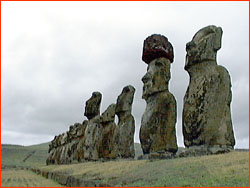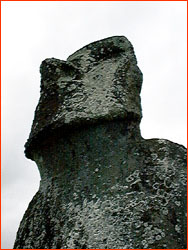
|
 |
 |
 Stone Giants
Stone GiantsOn average, they stand 13 feet high and weigh 14 tons, human heads-on-torsos carved in the male form from rough hardened volcanic ash. The islanders call them "moai," and they have puzzled ethnographers, archaeologists, and visitors to the island since the first European explorers arrived here in 1722. In their isolation, why did the early Easter Islanders undertake this colossal statue-building effort? Unfortunately, there is no written record (and the oral history is scant) to help tell the story of this remote land, its people, and the significance of the nearly 900 giant moai that punctuate Easter Island's barren landscape. What do they mean? The moai and ceremonial sites are along the coast, with a concentration on Easter Island's southeast coast. Here, the moai are more 'standardized' in design, and are believed to have been carved, transported, and erected between AD 1400 and 1600. They stand with their backs to the sea and are believed by most archaeologists to represent the spirits of ancestors, chiefs, or other high-ranking males who held important positions in the history of Easter Island, or Rapa Nui, the name given by the indigenous people to their island in the 1860s.  Archaeologist
Jo Anne Van Tilburg, who
has studied the moai for many years, believes the statues may
have been created in the image of various paramount chiefs.
They were not individualized portrait sculptures, but
standardized representations of powerful individuals. The moai
may also hold a sacred role in the life of the Rapa Nui,
acting as ceremonial conduits for communication with the gods.
According to Van Tilburg, their physical position between
earth and sky puts them on both secular and sacred ground;
secular in their representation of chief and their ability to
physically prop up the sky, and sacred in their proximity to
the heavenly gods. Van Tilburg concludes, "The moai thus
mediates between sky and earth, people and chiefs, and chiefs
and gods."
Archaeologist
Jo Anne Van Tilburg, who
has studied the moai for many years, believes the statues may
have been created in the image of various paramount chiefs.
They were not individualized portrait sculptures, but
standardized representations of powerful individuals. The moai
may also hold a sacred role in the life of the Rapa Nui,
acting as ceremonial conduits for communication with the gods.
According to Van Tilburg, their physical position between
earth and sky puts them on both secular and sacred ground;
secular in their representation of chief and their ability to
physically prop up the sky, and sacred in their proximity to
the heavenly gods. Van Tilburg concludes, "The moai thus
mediates between sky and earth, people and chiefs, and chiefs
and gods." What is an ahu? The word "ahu" has two meanings in Easter Island culture. First, an ahu is the flat mound or stone pedestal upon which the moai stand. The ahus are, on average, about four feet high. The word 'ahu' also signifies a sacred ceremonial site where several moai stand. Ahu Akivi, for example, is an ahu site with seven standing moai. Moai Stats The following statistics on Easter Island's moai are the results of Van Tilburg's survey in 1989. She reported, "A total of 887 monolithic statues has been located by the survey to date on Easter Island...397 are still in situ in quarries at the Rano Raraku central production center.....Fully 288 statues (32% of 887) were successfully transported to a variety of image ahu locations....Another 92 are recorded as "in transport," 47 of these lying in various positions on prepared roads or tracks outside the Rano Raraku zone." Number of Moai
Size and weight of moai Measuring the size, weight, and shape of the 887 moai on Easter Island has been a 15-year process for Van Tilburg. The most notable statues are listed below:
First Inhabitants | Ancient Navigation | Stone Giants | First Contact Photos: Liesl Clark Move a Megalith | Dispatches | Explore the Island | Lost Civilization Resources | E-mail | Table of Contents | Easter Island Home Editor's Picks | Previous Sites | Join Us/E-mail | TV/Web Schedule About NOVA | Teachers | Site Map | Shop | Jobs | Search | To print PBS Online | NOVA Online | WGBH © | Updated November 2000 |